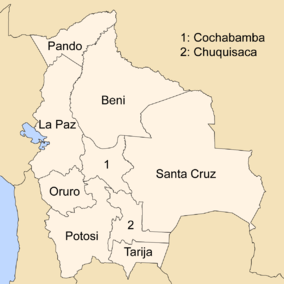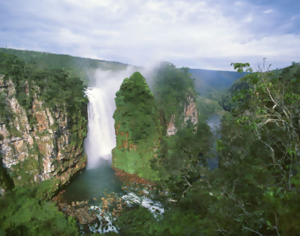- Noel Kempff Mercado National Park
-
Noel Kempff Mercado National Park IUCN Category II (National Park)Location Santa Cruz Department, Bolivia Coordinates 14°16′0″S 60°52′0″W / 14.266667°S 60.866667°WCoordinates: 14°16′0″S 60°52′0″W / 14.266667°S 60.866667°W Area 15,234 km² Established June 28, 1979 Type: Natural Criteria: ix, x Designated: 2000 (24th session) Reference #: 967 State Party:  Bolivia
BoliviaRegion: Latin America and the Caribbean Noel Kempff Mercado National Park is a national park in northeast Santa Cruz Department, Province of José Miguel de Velasco, Bolivia, on the border with Brazil.
Contents
Date of creation
Founded on June 28, 1979, the park was originally named "Parque Nacional Huanchaca." Less than a decade later, in 1988, the park was renamed "Parque Nacional Noel Kempff Mercado" in honor of the late pioneering biologist and Bolivian conservationist Prof. Noel Kempff Mercado, both for his research and discoveries in the Park and in memory of his tragic death in the area; Mercado was murdered in the park by drug traffickers when he inadvertently stumbled across a secret cocaine laboratory high on the Huanchaca plateau. [1]
Description
Noel Kempff Mercado National Park occupies 15,234 km² (5,880 mi²) in the northeastern corner of the Bolivian department of Santa Cruz de la Sierra. The Park is dominated by a large tableland of 7000 sq km, the Bolivian side of which is Serrania Huanchaca, and the Brazilian side is Sererania Ricardo Franco. The intervening Rio Verde marks the national boundary. The tableland is bounded by precipitous cliffs, 200 to 700 metres in height. The area was explored in 1908 by Col. Percy Harrison Fawcett on a frontier survey for the Bolivian government. In London, he showed photographs to Arthur Conan Doyle, which fired Doyle's imagination for him to write the novel The Lost World. One of the most biologically diverse areas in the world, Bolivia is known for its diversity in climate, fauna and flora. Weather in the general area is very hot and humid throughout the year, with abundant rainfall reaching roughly 1500 mm. The five driest months are May to September inclusive, during which rainfall is about 20 per cent of the annual figure.
Geology
The rocks of the tableland comprise Proterozoic sandstones, deposited around 1000 million years ago, intruded by a tholeiitic sill/dyke complex. These overlie an older basement of granites and metamorphic rocks which crop out over the Amazonic plain. The surface of the tableland is overlain by Cretaceous sandstones, and there are laterites and siliceous duricrusts which mark stages of Tertiary uplift and peneplanation[2].
Flora
It is estimated that the park is home to approximately 4.000 species of vascular plants, including bromelias, passifloras, heliconias, aráceas and palm trees. There are also important woods like the "Mara" (mahogany). The area encompasses five important ecosystems ranging from Amazonian rain forest, gallery forest and semi-deciduous tropical forest to flooded savanna and dry cerrado.
Fauna
The park is also home to more than 130 species of mammals (rare river otters, river dolphins, tapirs, spider and howler monkeys, the giant armadillo, giant anteaters and endangered jaguars, including a population of black jaguars), 620 species of birds (nine species of macaw, possibly the highest number of species in any one protected area), and more than 70 species of reptiles, including the black caiman (Melanosuchus niger).
Birds
In this area there are more than 617 species of birds — 20% of the all bird species in South America. Recent studies indicate that these numbers will increase once migratory birds are included.
Reptiles
In this park there exist nearly 74 species of reptiles including the black caiman, snakes, and other rare species.
Invertebrates
The park has 347 species of insect, among them the rarest in the world. They are unfortunately not studied yet.
Principal goals
General objective: To protect this unpolluted, non-industrialized natural area of great diversity.
Specific goals:
- Guarantee protection of the park's ecosystems
- Contribute to scientific research
- Enjoyment by visitors
- Show visitors an unpolluted area with beautiful locations
- Help the people that live here to improve their lifestyle
Threats the park faces:
- Turtle hunting, poaching
- Fishing
- Industrialized forest fires
- Illegal forest exploitation
- Narco-trafficking
- Financial problems
See also
References
External links
- Official Noel Kempff Mercado National Park website (Not currently functioning.)
- Official UNESCO website entry
- World Conservation Monitoring Centre
- Short amateur video of waterfall Arco Iris in Noel Kempff Mercado National Park
- Short amateur video of waterfall Ahlfeld in Noel Kempff Mercado National Park
National parks of Bolivia National Parks Reserves Integrated Management Natural Areas Apolobamba · El Palmar · San MatíasWorld Heritage Sites in Bolivia Jesuit Missions of the Chiquitos · Fuerte de Samaipata · Noel Kempff Mercado National Park · City of Potosí · Historic City of Sucre · Tiwanaku: Spiritual and Political Centre of the Tiwanaku Culture
 Categories:
Categories:- IUCN Category II
- World Heritage Sites in Bolivia
- National parks of Bolivia
- Protected areas established in 1979
Wikimedia Foundation. 2010.



